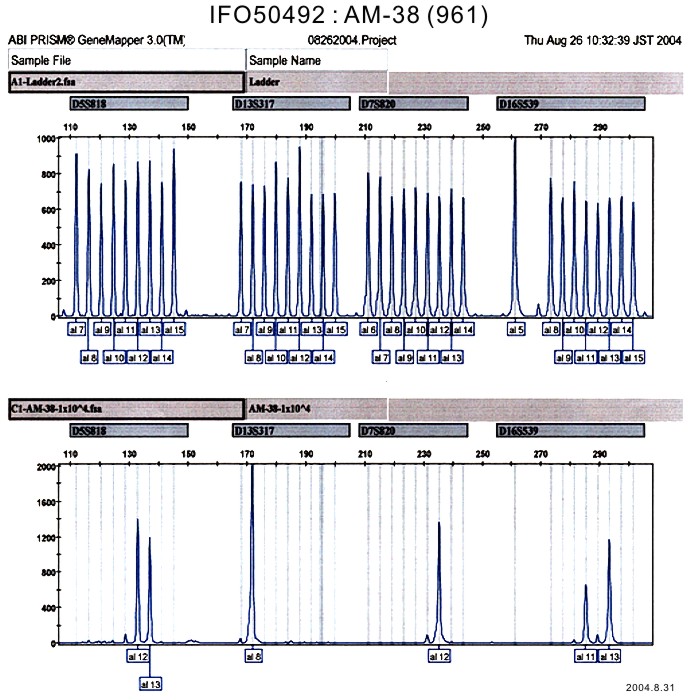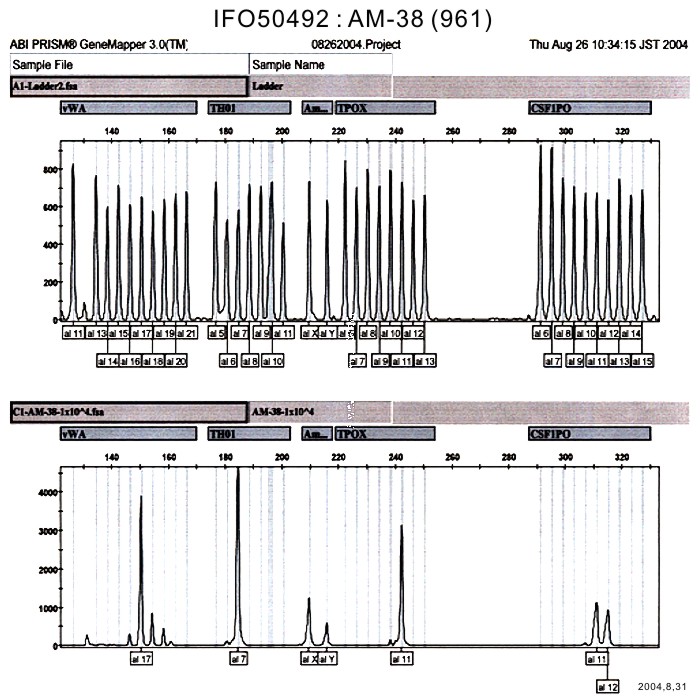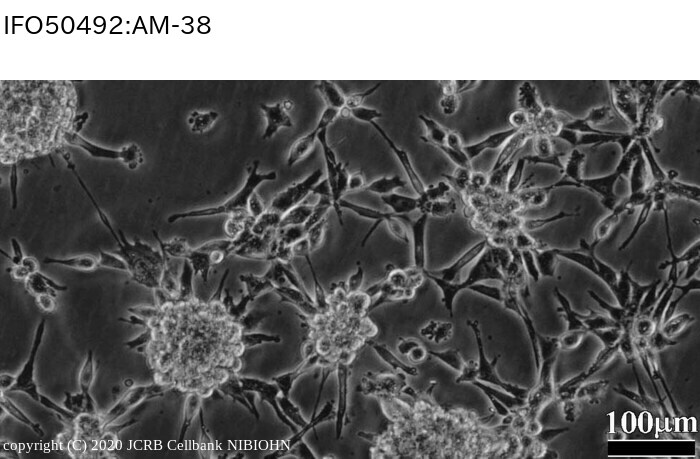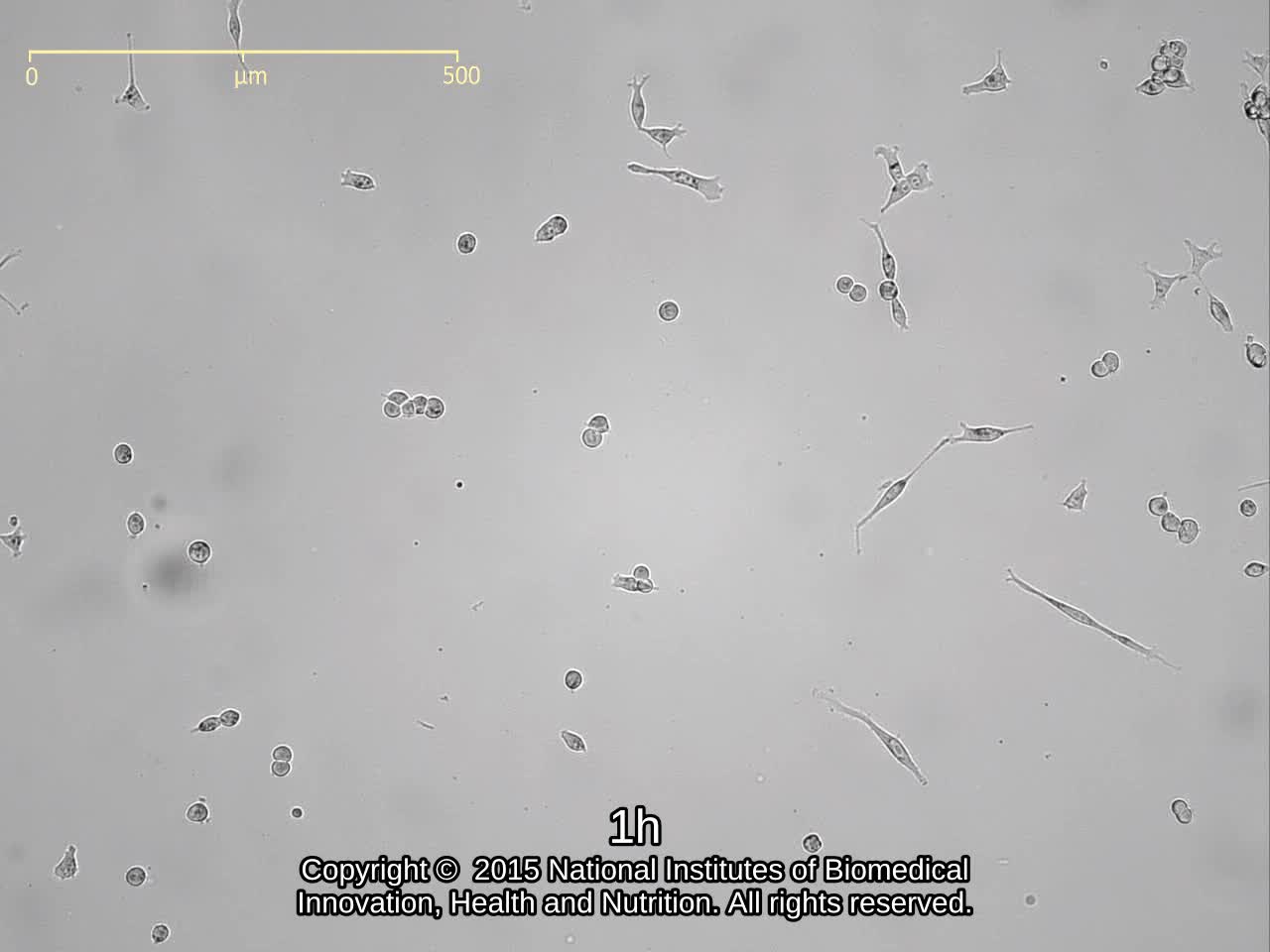IFO50492 AM-38
Cell information
Cell type:general cells (View Pricing Information)
| JCRB No. | IFO50492 | Cell Name | AM-38 |
|---|---|---|---|
| Profile | glioblastoma, GFAP and S-100-positive, ACNU(a cancer chemotherapy drug)-sensitive | Other Name | |
| Animal | human | Strain | |
| Genus | Homo | Species | sapiens |
| Sex | M | Age | 36 |
| Identity | available | Tissue for Primary Cancer | neural |
| Case history | glioblastoma | Metastasis | |
| Tissue Metastasized | Genetics | ||
| Life Span | infinite | Crisis PDL | |
| Morphology | Character | glioblastoma, GFAP and S-100-positive, ACNU (a cancer chemotherapy drug)-sensitive | |
| Classify | tumor | Established by | Izumi, I. et al. |
| Registered by | Minemura,K. | Regulation for Distribution | |
| Comment | Year | 1998 | |
| Medium | Eagle's minimal essential medium with 20% heat-inactivated fetal bovine serum | Methods for Passages | trypsin-EDTA |
| Cell Number on Passage | Race | ||
| CO2 Conc. | 5 % | Tissue Sampling | brain |
| Tissue Type |
| Detection of virus genome fragment by Real-time PCR | |||||||||
|---|---|---|---|---|---|---|---|---|---|
| Detected DNA Virus | tested | Detected RNA Virus | tested | ||||||
| CMV | - | parvoB19 | - | HCV | - | HTLV-1 | - | ||
| EBV | - | HBV | - | HIV-1 | - | HTLV-2 | - | ||
| HHV6 | - | HTLV-1 | - | HIV-2 | - | HAV | - | ||
| HHV7 | - | HTLV-2 | - |
-/negative. +/positive. nt/not tested. (positive (+) does not immediately mean the production of infectious viral particles.) |
|||||
| BKV | - | HIV-1 | - | ||||||
| JCV | - | HIV-2 | - | ||||||
| ADV | - | HPV18 | - | ||||||
| Notes | |||||||||
| Reference | |
|---|---|
| Pubmed id:8605218 | Quantification of O6-methylguanine-DNA methyltransferase mRNA in human brain tumors. Mineura K,Watanabe K,Yanagisawa T,Kowada M Biochim Biophys Acta. 1996 Feb 9;1289(1):105-9 |
| Pubmed id:7947440 | Establishment of the two glioma cell lines: YH and AM. Izumi I,Mineura K,Watanabe K,Kowada M Hum Cell. 1994 Jun;7(2):101-5 |
| Pubmed id:8145054 | Characterization and chemosensitivity of two cell lines derived from human glioblastomas. Izumu I,Mineura K,Watanabe K,Kowada M J Neurooncol. 1993 Aug;17(2):111-21 |
| Research results by users. Click! | |
|---|---|
| Pubmed id:32687679 |
Epithelioid glioblastoma with microglia features: potential for novel therapy. Nakagomi N,Sakamoto D,Hirose T,Takagi T,Murase M,Nakagomi T,Yoshimura S,Hirota S Brain Pathol. 2020 Nov;30(6):1119-1133 |
| Images |
|---|
   |
| Movies |
|---|

|
LOT Information
Viability/Growth rate/Cell number are represented as actual values measured at lot presentation in JCRB, but are not guaranteed values. Additionally, the doubling time is a rough value measured during passages.| Cell No. | IFO50492 | Cell Name | |
|---|---|---|---|
| LOT No. | 12082003 | Lot Specification | distribution |
| Medium | Eagle's minimal essential medium with 20% fetal bovine serum (FBS lot; GIBCO 3792782S) | Temperature | 37 C |
| Cell Density at Seeding | 1 x 10^5 cells/ml | Methods for Passages | 0.25% trypsin and 0.02% EDTA |
| Doubling Time | D.T. = ca. 1.6 days | Cell Number in Vial (cells/1ml) | 1.9 x 10^6 |
| Viability at cell freezing (%) | 89.6 | Antibiotics Used | free |
| Passage Number | P7* | PDL | |
| Sterility: MYCOPLASMA | - | Sterility: BACTERIA | - |
| Sterility: FUNGI | - | Isozyme Analysis | Confirmed as human by NP, G6PD (type B), AST, LD. |
| Chromosome Mode | Chromosome Information | ||
| Surface Antigen | DNA Profile (STR) | ||
| Adhesion | Yes | Exoteric Gene | |
| Medium for Freezing | 10% DMSO, 20% FBS - EMEM | CO2 Conc. | 5% |
| Viability immediately after thawing (%) | Additional information |
| Cell No. | IFO50492 | Cell Name | AM-38 |
|---|---|---|---|
| LOT No. | 961 | Lot Specification | seed/distribution |
| Medium | E.MEM, 80% ; inact. FBS, 20% | Temperature | 37 C |
| Cell Density at Seeding | Methods for Passages | trypsin-EDTA | |
| Doubling Time | Cell Number in Vial (cells/1ml) | 3 x 10^6 | |
| Viability at cell freezing (%) | 96 | Antibiotics Used | free |
| Passage Number | Unknown (4 at IFO) | PDL | |
| Sterility: MYCOPLASMA | - | Sterility: BACTERIA | - |
| Sterility: FUNGI | - | Isozyme Analysis | NP, G6PD(type B), AST |
| Chromosome Mode | Chromosome Information | ||
| Surface Antigen | DNA Profile (STR) | D5S818:12,13 D13S317:8 D7S820:12 D16S539:11,13 VWA:17 TH01:7 AM:XY TPOX:11 CSF1PO:11,12 |
|
| Adhesion | Exoteric Gene | ||
| Medium for Freezing | 10% DMSO, 20% serum (final conc.) - culture medium | CO2 Conc. | |
| Viability immediately after thawing (%) | Additional information |
| Images |
|---|
  |
| Cell No. | IFO50492 | Cell Name | AM-38 |
|---|---|---|---|
| LOT No. | 09082014 | Lot Specification | distribution |
| Medium | Eagle's minimum essential medium with 20% heat-inactivated fetal bovine serum (FBS; GIBCO Cat. # 10091). | Temperature | 37 C |
| Cell Density at Seeding | approx. 1 x 10^5 cells/mL | Methods for Passages | Cells were harvested after treatment with 0.25% trypsin and 0.02% EDTA. |
| Doubling Time | approx. 38 hrs | Cell Number in Vial (cells/1ml) | 2.6 x 10^6 |
| Viability at cell freezing (%) | 95 | Antibiotics Used | free |
| Passage Number | Unknown (6 at bank) | PDL | |
| Sterility: MYCOPLASMA | - | Sterility: BACTERIA | - |
| Sterility: FUNGI | - | Isozyme Analysis | Confirmed as human by NP, G6PD (type B), MD. |
| Chromosome Mode | Chromosome Information | ||
| Surface Antigen | DNA Profile (STR) | D5S818:12,13 D13S317:8 D7S820:12 D16S539:11,13 VWA:17,18,19 TH01:7 AM:X,Y TPOX:11 CSF1PO:11,12 |
|
| Adhesion | Yes | Exoteric Gene | |
| Medium for Freezing | 10% DMSO, 20% FBS - EMEM | CO2 Conc. | 5% |
| Viability immediately after thawing (%) | 95 | Additional information | Ampule was mislabeled as IFO50592. Correct number is IFO50492. |
| Cell No. | IFO50492 | Cell Name | AM-38 |
|---|---|---|---|
| LOT No. | 11152018 | Lot Specification | distribution |
| Medium | Eagle's minimum essential medium with 20% heat-inactivated fetal bovine serum (FBS; Sigma Cat. # 172012) | Temperature | 37 C |
| Cell Density at Seeding | approx. 1 x 10^5 cells/mL | Methods for Passages | Cells were harvested after treatment with 0.25% trypsin and 0.02% EDTA. |
| Doubling Time | approx. 32 hrs. | Cell Number in Vial (cells/1ml) | 2.9 x 10^6 |
| Viability at cell freezing (%) | 96 | Antibiotics Used | free |
| Passage Number | Unknown (7 at bank) | PDL | |
| Sterility: MYCOPLASMA | - | Sterility: BACTERIA | - |
| Sterility: FUNGI | - | Isozyme Analysis | |
| Chromosome Mode | Chromosome Information | ||
| Surface Antigen | DNA Profile (STR) | ||
| Adhesion | Yes | Exoteric Gene | |
| Medium for Freezing | 10% DMSO, 20% FBS - EMEM | CO2 Conc. | 5% |
| Viability immediately after thawing (%) | 93 | Additional information | Essentially AM-38 has been maintained as adherent culture, but the attachment is very weak Some cells will form aggregates and these aggregates may sometimes detach from the surface of culture dish. |
| Cell No. | IFO50492 | Cell Name | AM-38 |
|---|---|---|---|
| LOT No. | 11242023 | Lot Specification | distribution |
| Medium | Eagle's minimum essential medium with 20% fetal bovine serum (FBS; Cat. # Nichirei 174112, Lot 20M00K) | Temperature | 37 C |
| Cell Density at Seeding | approx. 1.5 x 10^5 cells/mL | Methods for Passages | Cells were harvested after treatment with 0.25% trypsin and 0.02% EDTA. |
| Doubling Time | approx. 32 hrs. | Cell Number in Vial (cells/1ml) | 1.6 x 10^6 |
| Viability at cell freezing (%) | 99 | Antibiotics Used | free |
| Passage Number | Unknown (7 at bank) | PDL | |
| Sterility: MYCOPLASMA | - | Sterility: BACTERIA | - |
| Sterility: FUNGI | - | Isozyme Analysis | |
| Chromosome Mode | Chromosome Information | ||
| Surface Antigen | DNA Profile (STR) | D5S818:12,13 D13S317:8 D7S820:12 D16S539:11,13 VWA:17,18,19 TH01:7 AM:X,Y TPOX:11 CSF1PO:11,12 |
|
| Adhesion | Yes | Exoteric Gene | |
| Medium for Freezing | 10% DMSO, 20% FBS - EMEM | CO2 Conc. | 5% |
| Viability immediately after thawing (%) | 95 | Additional information | Essentially AM-38 has been maintained as adherent culture, but the attachment is very weak. Some cells will form aggregates and these aggregates may sometimes detach from the surface of culture dish. |